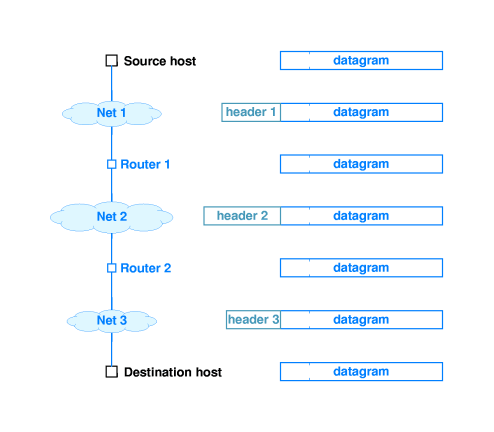(Latest Revision:
Mon Apr 2 18:17:48 PDT 2007
)
Notes On Chapter Twenty-One
-- IP Encapsulation, Fragmentation, And Reassembly
- 21.1 Introduction
- This chapter explains details about the means by which datagrams
get across physical networks.
-
- 21.2 Datagram Transmission And Frames
- Each time an IP datagram crosses a network it has to "go by the
rules" of that network.
-

- 21.3 Encapsulation
- Encapsulation is the the "trick" we use to shuttle IP
packets across a physical network: the IP packet is just placed
in the data portion of a physical network frame.
- Of course the correct physical address of the next-hop host or
router has to go into the proper field of the physical frame
- Also the physical frame must contain a type field marking it as
the carrier of IP traffic, so that the contents of the frame will
be handed off to IP software running on the destination host.
-

- 21.4 Transmission Across An Internet
- The physical frame is received at the link layer on the router.
When it is passed to the network layer, the IP packet is removed
and the containing frame is discarded.
- To send the IP packet to the next hop the router places the
packet in a new frame, appropriate to the network it will travel
over next.
- An IP datagram does not accumulate more and more "trip headers"
as it moves across the Internet. As described above, the packet
is returned to its original state on each transmitting router.
-

- 21.5 MTU, Datagram Size, And Encapsulation
- Each network has a maximum transmission unit
(MTU)
- The MTU is the maximum size physical frame the network can accept
for transit.
- Problem: It can happen that an IP datagram
arriving at a router cannot be forwarded intact to the next hop
because the MTU of the next link is so small that the IP
packet will not fit in the data section of a physical frame.
- Solution: IP routers can break an IP datagram
into a series of "fragment" datagrams, each of which carries
a portion of the data from the original datagram.
- The IP software on the router carefully constructs each fragment
datagram so it fits within the data portion of a physical network
frame.
- A bit in the FLAGS field marks a datagram as a
fragment. Each fragment is assigned a diferent FRAGMENT
OFFSET. This is all that is required to allow the receiver to
reassemble the packet.
- The header of each fragment is basically a copy of the header of
the original IP datagram -- with the obvious changes made, such as
TOTAL LENGTH, FLAGS, and FRAGMENT OFFSET fields.
-

- 21.6 Reassembly
- You might think that the next hop router would reassemble the
fragmented packet -- not true.
- Packet reassembly is the responsibility of
the ultimate destination host.
- When a router fragments a packet P, the router
may forward different fragments over different routes. In
that case there is probably more than one
next-hop router, and so the job of reassembly cannot be done on a
next-hop router.
- Also, routers are busy and should not
have to be "bothered" with doing reassembly.
-

- 21.7 Identifying A Datagram
- Fragments can be lost, delayed, or delivered out of order.
- The receiver recognizes a fragment from one particular datagram by
looking at the combination of sender IP address, and the
IDENTIFICATION field of the packet (fragment).
-
- 21.8 Fragment Loss
- When the first fragment arrives, the receiver
starts a timer. If the timer expires before all the fragments have
arrived then the receiver rejects the entire packet.
- Fragment delivery is "all or nothing at all."
- It is not practical to request that a fragment
be resent.
- There is no guarantee that a packet will be
fragmented again in the same way if the packet is resent.
-
- 21.9 Fragmenting A Fragment
- A fragment can itself be fragmented if it runs into a network with
an MTU so small that it cannot get through.
- One thing that helps with this is that the
FRAGMENT OFFSET denotes the offset of the fragment in the original
packet. The FRAGMENT OFFSET is not a "serial number"
- A fragment of a fragment is still just an
ordinary fragment. At reassembly time there is no need to
assemble "sub-fragments" into "fragments."
-
- 21.10 Summary




